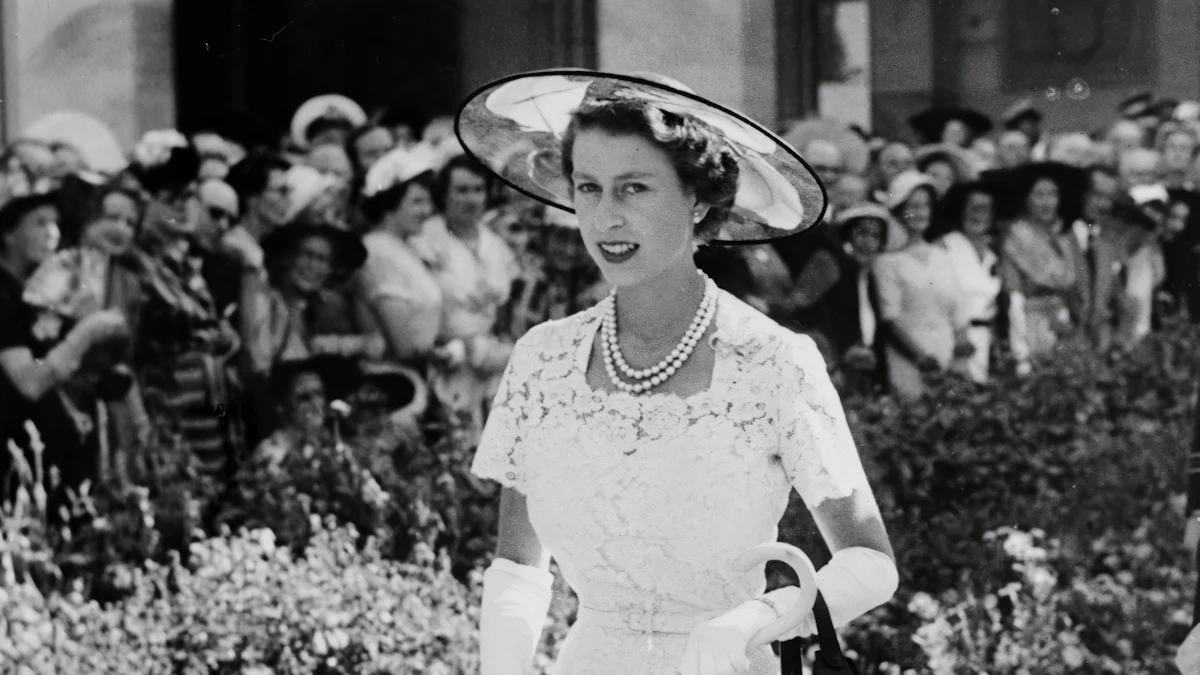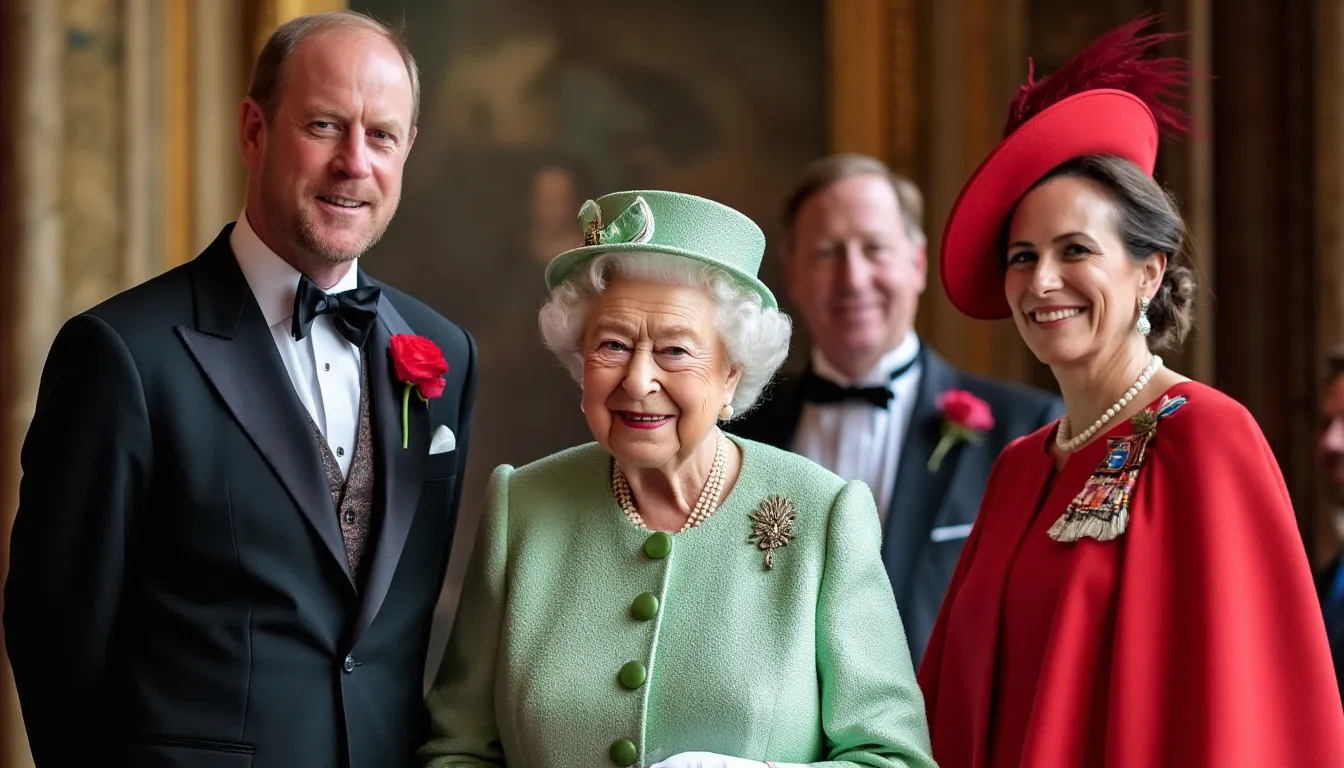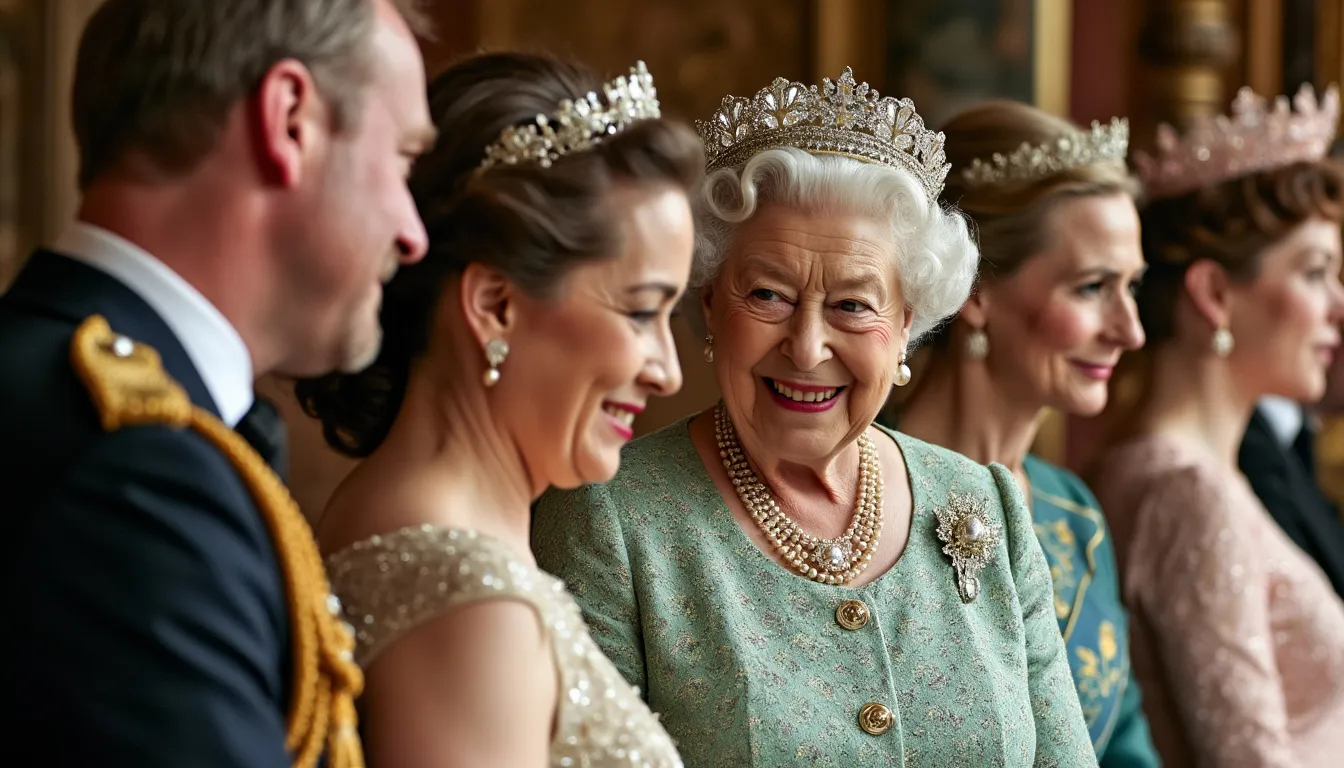Queen Elizabeth II and the Royal Family

Queen Elizabeth II stands as a symbol of enduring legacy. Her reign reflects the deep-rooted traditions of the British monarchy. The Royal Family holds a significant place in British culture. This institution influences national identity and public life. The monarchy's historical impact spans centuries, shaping societal values and customs. Surveys reveal strong support for the monarchy, though opinions vary by age group. The Royal Family continues to captivate global attention, blending tradition with modernity.
Early Life and Ascension of Elizabeth

Childhood and Education of Princess Elizabeth
Family Background and Early Influences
Elizabeth, known formally as Elizabeth Alexandra Mary, was born into the British royal family. Her parents, the Duke and Duchess of York, later became King George VI and Queen Elizabeth. Elizabeth's early life was steeped in royal tradition. Her family background played a significant role in shaping her character. The young princess received education at home, focusing on history, language, and music. Elizabeth's upbringing emphasized duty and service, preparing her for future responsibilities.
Life during the Blitz and World War II
The Blitz had a profound impact on Elizabeth's formative years. During World War II, Elizabeth and her sister Margaret spent much of their time at Windsor Castle. The war years were challenging, but Elizabeth showed resilience and determination. She carried out her first public duties during this period, visiting hospitals and supporting war efforts. Elizabeth's experiences during the war instilled a sense of duty and commitment to her country.
Becoming Queen Elizabeth
The Abdication Crisis and its Impact
The abdication crisis of 1936 changed the course of Elizabeth's life. Her uncle, King Edward VIII, abdicated the throne, making her father the king. This unexpected event thrust Elizabeth into the position of heir presumptive. The crisis heightened public interest in Elizabeth's future role. She began studying constitutional history and law to prepare for her responsibilities. The abdication marked a turning point in the life of Queen Elizabeth, setting her on the path to becoming a monarch.
Coronation and Early Reign
Elizabeth ascended to the throne in 1952 after the death of her father, King George VI. Her coronation took place in 1953, marking the beginning of her reign. The ceremony was a significant event, symbolizing continuity and tradition. Elizabeth's early reign faced challenges, including post-war recovery and changing societal norms. She worked tirelessly to uphold the monarchy's image and adapt to modern times. The biography of Queen Elizabeth highlights her dedication and service throughout her reign.
Role and Responsibilities of Queen Elizabeth
Constitutional Duties of the Queen
Head of State and Parliamentary Relations
Queen Elizabeth II served as the head of state for the United Kingdom. Her role involved a range of constitutional duties. The Queen opened and dissolved Parliament. She approved bills passed by Parliament, granting them royal assent. These actions symbolized the continuity and stability of the British government.
The Queen maintained a neutral position in political matters. This neutrality allowed her to work with various governments. Her presence provided a steadying influence during times of change. Various Experts noted that Elizabeth's reign marked vast changes in Britain's power and global perception.
Involvement in the ATS during World War II
During World War II, Elizabeth joined the Auxiliary Territorial Service (ATS). This involvement marked her commitment to public service. The ATS trained Elizabeth in vehicle maintenance and driving. Her participation in the Auxiliary Territorial Service demonstrated her dedication to the nation. This experience shaped her understanding of duty and responsibility.
Public Engagements and Royal Visits
Charitable Work and Service
Queen Elizabeth engaged in numerous public activities. Her charitable work formed a significant part of her responsibilities. The Queen supported over 600 organizations. These charities focused on diverse causes, including education, health, and the environment. Her involvement highlighted her commitment to service and community welfare.
International Visits and Diplomatic Relations
Queen Elizabeth's international visits played a crucial role in diplomacy. Her travels strengthened relations between the United Kingdom and other nations. Although she did not make political statements, her presence held diplomatic significance. Various Experts emphasized her central role in building the soft power of Britain.
The Queen's visits showcased British culture and values. These engagements fostered goodwill and mutual understanding. Her diplomatic efforts contributed to the monarchy's global influence.
Significant Milestones in Queen Elizabeth's Reign

Silver, Golden, and Diamond Jubilees
Celebrations and Public Reactions
Queen Elizabeth celebrated several significant jubilees during her reign. The Silver Jubilee in 1977 marked 25 years on the throne. The nation organized street parties and parades to honor the Queen's service. Public enthusiasm reflected the deep affection for the monarchy. The Golden Jubilee in 2002 celebrated 50 years of her reign. This milestone included a series of events across the United Kingdom. The public showed immense support, highlighting the Queen's enduring popularity.
The Diamond Jubilee in 2012 marked 60 years of Queen Elizabeth's reign. The celebrations included a grand pageant on the River Thames. Millions of people participated in events worldwide. The global outpouring of admiration underscored her influence and legacy. These jubilees became a testament to the Queen's steadfast dedication to her role.
Legacy and Impact on the British Monarchy
Queen Elizabeth's jubilees left a lasting legacy on the British monarchy. Her reign symbolized continuity and stability in a rapidly changing world. The Queen's commitment to duty earned respect from people of all ages. Her ability to adapt to societal changes ensured the monarchy's relevance. The jubilees reinforced the monarchy's place in British culture. The celebrations created a shared national experience, uniting people across generations.
Modernization of the Monarchy
Media and Public Perception
The modernization of the monarchy involved adapting to new media landscapes. Queen Elizabeth embraced television and radio to connect with the public. Her televised Christmas broadcasts became a cherished tradition. The media played a crucial role in shaping public perception of the monarchy. The Queen's openness to media engagement enhanced transparency. This approach helped maintain public interest and trust in the royal family.
Media coverage of royal events brought the monarchy closer to the people. The Queen's presence in documentaries and interviews showcased her human side. The media's portrayal of the monarchy evolved over time, reflecting societal changes. The Queen's ability to navigate media challenges demonstrated her adaptability. The monarchy's relationship with the media remains a vital aspect of its modern identity.
Changes in Royal Protocol
Queen Elizabeth introduced changes in royal protocol to reflect contemporary values. The monarchy adapted to evolving social norms and expectations. The Queen's efforts to modernize the institution included embracing diversity. The royal family supported various charitable causes and initiatives. These changes aimed to make the monarchy more inclusive and relevant.
The Queen's commitment to modernization extended to environmental issues. The royal family advocated for sustainability and conservation efforts. The monarchy's involvement in social causes highlighted its evolving role. The changes in royal protocol reflected the Queen's vision for a modern monarchy. Her leadership ensured the monarchy's continued significance in the 21st century.
The Royal Family's Influence and Key Figures

Key Figures in the Royal Family
Prince Philip and his Role
Prince Philip, the Duke of Edinburgh, played a pivotal role in supporting Queen Elizabeth II throughout her reign. His marriage to Elizabeth marked a union that lasted over seven decades. Philip's dedication to public service became evident through his involvement in numerous charitable organizations. The Duke of Edinburgh Award, established by Prince Philip, encouraged young people to engage in community service and personal development activities. His commitment to duty and service mirrored the values upheld by the British royal family.
The Duke of Edinburgh's influence extended beyond his official duties. His presence at Buckingham Palace symbolized stability and continuity within the monarchy. Prince Philip attending Royal events showcased his unwavering support for the Queen. His legacy continues to inspire future generations of the royal family.
The Heirs: Prince Charles, William, and Harry
Prince Charles, the eldest son of Queen Elizabeth II, stands as the heir apparent to the throne. Charles Philip Arthur George has dedicated his life to public service and environmental advocacy. His initiatives, such as the Prince's Trust, have positively impacted countless lives. Prince Charles's commitment to sustainability reflects his vision for a better future.
Prince William and Prince Harry, the sons of Prince Charles, represent the next generation of the British royal family. Both Princes have embraced their roles with dedication and compassion. Prince William focuses on mental health awareness and conservation efforts. Prince Harry, known for his philanthropic work, has championed causes related to veterans and mental health. The heirs continue to uphold the values of duty and service instilled by their grandmother, Queen Elizabeth II.
Cultural and Social Impact of the Royal Family
Royal Weddings and Public Interest
Royal weddings captivate the world, drawing immense public interest and media attention. The marriage of Prince Charles to Lady Diana Spencer in 1981 became a global spectacle. The event highlighted the enduring fascination with the British royal family. Royal weddings symbolize tradition and continuity within the monarchy.
The weddings of Prince William to Catherine Middleton and Prince Harry to Meghan Markle further exemplified this cultural phenomenon. These events attracted millions of viewers worldwide, showcasing the royal family's influence on popular culture. The British royal family watching these ceremonies reinforced their connection to the public.
Philanthropy and Advocacy
Philanthropy remains a cornerstone of the royal family's influence. Queen Elizabeth II Fast Facts highlight her support for over 600 charitable organizations. The royal family's advocacy spans diverse causes, including education, health, and the environment. Their involvement underscores a commitment to improving society.
The Family Order of Elizabeth exemplifies the royal family's dedication to service. Members of the royal family actively participate in charitable initiatives, raising awareness and funds for important causes. The National Records of Scotland document the impact of their philanthropic efforts. The royal family's advocacy inspires others to contribute to positive change.
Challenges and Controversies Facing the Royal Family
Scandals and Public Scrutiny
Media Coverage and Public Opinion
The British royal family has faced intense media scrutiny over the years. The public's fascination with the monarchy often leads to widespread coverage of both positive and negative events. Queen Elizabeth's reign saw numerous scandals that captured global attention. The media played a significant role in shaping public opinion about these controversies. The press often highlighted personal issues within the royal family, affecting their public image.
Queen Elizabeth maintained a dignified approach during these challenging times. Her ability to remain composed under pressure earned respect from many. The media's portrayal of the royal family influenced public perception. The monarchy's response to scandals demonstrated resilience and adaptability.
The Role of Princess Margaret
Princess Margaret, the younger sister of Queen Elizabeth, often found herself in the spotlight. Her life attracted media attention due to her glamorous lifestyle and relationships. Princess Margaret's actions sometimes led to public criticism, impacting the royal family's reputation. Her role within the monarchy highlighted the challenges of balancing personal desires with royal duties.
Princess Margaret's experiences underscored the pressures faced by members of the royal family. Her life illustrated the complexities of living under constant public scrutiny. The royal family navigated these challenges while maintaining their commitment to duty and service.
The Future of the Monarchy
Succession Plans and King Charles III
The future of the British monarchy involves careful planning and preparation. Prince Charles, now King Charles III, stands as the heir apparent following Queen Elizabeth's reign. His succession marks a new chapter for the royal family. King Charles III's leadership will shape the monarchy's direction in the coming years.
Succession plans ensure a smooth transition of power within the monarchy. The Order of succession outlines the line of heirs to the throne. King Charles III's reign will bring changes and challenges as he assumes his new role. The monarchy's ability to adapt will determine its continued relevance.
Evolving Roles and Responsibilities
The roles and responsibilities of the royal family continue to evolve. Queen Elizabeth's reign witnessed significant changes in the monarchy's function. The royal family embraced modernization to remain relevant in contemporary society. New generations of royals, including Prince William and Prince Harry, contribute to this evolution.
The monarchy's involvement in social causes reflects its commitment to positive change. The royal family supports various charitable initiatives, addressing issues such as mental health and environmental sustainability. The evolving roles of the monarchy highlight its dedication to serving the public.
Queen Elizabeth's legacy remains a testament to her unwavering dedication and service. Her reign symbolized continuity and stability for the British monarchy. The influence of Queen Elizabeth extended beyond national borders, impacting global perceptions of the monarchy. The Royal Family continues to hold relevance in modern society, adapting to changing times while maintaining traditions. Charles now faces the challenge of steering the monarchy into the future. The Order of succession ensures a smooth transition, but evolving societal expectations require adaptability. The future of the British monarchy depends on its ability to balance tradition with progress.
See Also
Royal Fashion Trends: A Regal Lookbook
Visual Journey Through British and Irish History
Presidential Facts: Illustrated Reference

